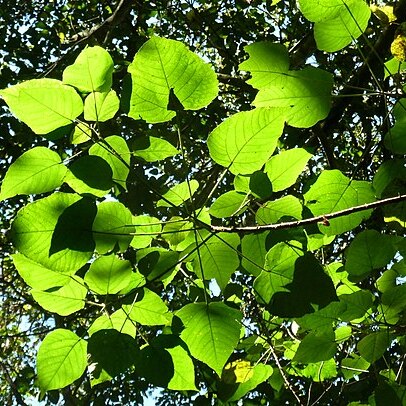A tree up to 25 m high; crown rounded, spreading; stem ± buttressed. Trunk and branches with short spines. Bark light grey with white horizontal markings, smooth. Young growth densely ferruginous-tomentellous at first, later glabrescent. Stipules 1-2 cm x 4-8 mm, lanceolate, acutely acuminate, deciduous. Petioles up to 30 cm long, pulvinate at the base. Leaf blades up to 25 x 20 cm, broadly ovate to triangular-ovate, shortly acuminate at the apex, shallowly to deeply cordate or cordulate at the base, or if peltate then truncate or rounded at the base, entire or glandular-denticulate on the margins, firmly chartaceous, glabrescent on upper surface, hirsute beneath at least along the midrib and main nerves, densely gland-dotted beneath; 5-11-nerved from the base, lateral nerves in 6-14 pairs, looped, tertiary nerves parallel. Male inflorescences 8-12 cm long, paniculate; bracts 4-10 mm long, triangular ovate, adaxially glandular, strongly reflexed, many-flowered. Male flowers subsessile; calyx lobes 2-3, 0.75 mm long, ovate, yellowish-green; stamens 2-4, filaments ± free, 1 mm long, anthers minute, creamy-white. Female inflorescences 4-8 cm long, paniculate or subpaniculate; bracts 1-5-flowered. Female flowers shortly pedicellate, the pedicels c. 1-2 mm long; calyx urceolate, splitting into 2-4 lobes and becoming flattened as the fruit matures; ovary 1-1.5 x 0.75-1 mm, unlobed or rarely 2-lobed, densely yellowish-granulate-glandular; styles 1 or 2 and ± free, 2-3 mm long, recurved, fimbriate-papillose. Fruit 3-6 x 4-7(11) mm, subglobose, rarely 2-lobed, densely yellowish-green granulate-glandular at first, later becoming smooth, glabrous and green. Seeds 2.5-4 mm in diameter, subglobose, ± smooth, dull, red or black.
Perennial tree, 2.5-25.0 m high; deciduous; single-stemmed; trunk and branches with short thorns; bark smooth. Leaves alternate, firmly chartaceous, glabrous above, hirsute below; lamina broadly ovate to triangular-ovate, base shallowly to deeply cordate or cordulate, apex shortly acuminate, margins entire or glandular-denticulate. Stipules lanceolate, acutely acuminate, deciduous. Male inflorescences paniculate; bracts triangular-ovate, adaxially glandular, many-flowered. Male flowers subsessile; calyx lobes 2 or 3, ovate; stamens 2-4; filaments free; anthers minute. Female inflorescences paniculate or subpaniculate; bracts 1-5-flowered. Female flowers shortly pedicellate; calyx urceolate, splitting into 2-4 lobes; ovary unlobed or rarely 2-lobed; styles 1 or 2, free, recurved, fimbriate-papillose. Flowering time Aug.-Feb. Fruit a subglobose capsule, glabrous. Seeds subglobose, smooth.
Leaf blades up to 25 × 20 cm, broadly ovate to triangular-ovate, shortly acuminate at the apex, shallowly to deeply cordate or cordulate at the base, or if peltate then truncate or rounded at the base, entire or glandular-denticulate on the margins, firmly chartaceous, glabrescent on upper surface, hirsute beneath at least along the midrib and main nerves, densely gland-dotted beneath; 5–11-nerved from the base, lateral nerves in 6–14 pairs, looped, tertiary nerves parallel.
Female flowers shortly pedicellate, the pedicels c. 1–2 mm long; calyx urceolate, splitting into 2–4 lobes and becoming flattened as the fruit matures; ovary 1–1.5 × 0.75–1 mm, unlobed or rarely 2-lobed, densely yellowish-granulate-glandular; styles 1 or 2 and ± free, 2–3 mm long, recurved, fimbriate-papillose.
Male flowers subsessile; calyx lobes 2–3, 0.75 mm long, ovate, yellowish-green; stamens 2–4, filaments ± free, 1 mm long, anthers minute, creamy-white.
Fruit 3–6 × 4–7(11) mm, subglobose, rarely 2-lobed, densely yellowish-green granulate-glandular at first, later becoming smooth, glabrous and green.
Male inflorescences 8–12 cm long, paniculate; bracts 4–10 mm long, triangular ovate, adaxially glandular, strongly reflexed, many-flowered.
A tree. It grows 30 m tall. The trunk does not have branches for up to 12 m. The trunk is 60-100 cm across.
Female inflorescences 4–8 cm long, paniculate or subpaniculate; bracts 1–5-flowered.
Young growth densely ferruginous-tomentellous at first, later glabrescent.
Seeds 2.5–4 mm in diameter, subglobose, ± smooth, dull, red or black.
A tree up to 25 m high; crown rounded, spreading; stem ± buttressed.
Stipules 1–2 cm × 4–8 mm, lanceolate, acutely acuminate, deciduous.
Bark light grey with white horizontal markings, smooth.
Petioles up to 30 cm long, pulvinate at the base.
Trunk and branches with short spines.


